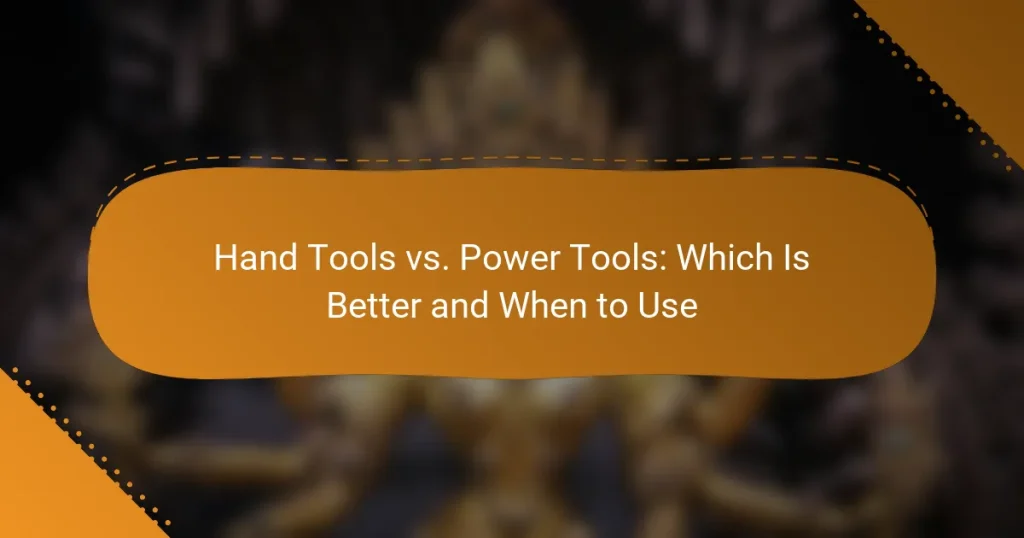When deciding between hand tools and power tools for your DIY projects, it’s essential to consider the specific requirements of the task. Hand tools provide unmatched precision and control, making them perfect for detailed work, while power tools deliver speed and efficiency, especially for larger or tougher jobs.

Which tools are better for DIY projects in the USA?
For DIY projects in the USA, the choice between hand tools and power tools depends on the specific task at hand. Hand tools excel in precision and control, while power tools offer speed and efficiency for larger jobs.
Hand tools for precision tasks
Hand tools are ideal for tasks that require accuracy and detail, such as woodworking or intricate repairs. Tools like chisels, hand saws, and screwdrivers allow for greater control, making them suitable for fine work.
When using hand tools, consider the material and the task complexity. For example, a chisel is perfect for shaping wood, while a hand saw provides clean cuts in smaller projects. Always ensure your tools are well-maintained for optimal performance.
Power tools for efficiency
Power tools are designed for speed and can significantly reduce the time needed to complete larger projects. Tools such as drills, circular saws, and sanders are excellent for tasks that involve repetitive actions or heavy materials.
When selecting power tools, assess the scale of your project. For instance, a power drill can handle multiple tasks quickly, while a table saw is essential for cutting large sheets of plywood. Always follow the manufacturer’s guidelines for safe operation.
Cost considerations for tools
Cost is a crucial factor when choosing between hand and power tools. Hand tools generally have a lower initial investment, often ranging from $10 to $100 per tool, while power tools can start at $50 and go into the hundreds or even thousands for advanced models.
Consider your budget and the frequency of use. If you plan to undertake many projects, investing in quality power tools may save money in the long run. However, for occasional tasks, a set of reliable hand tools may suffice.
Safety factors in tool selection
Safety is paramount when selecting tools for DIY projects. Hand tools typically pose fewer risks, but improper use can still lead to injuries. Always use the right tool for the job and wear appropriate safety gear, such as gloves and goggles.
Power tools require more caution due to their speed and potential hazards. Ensure you understand the safety features of each tool, and never bypass safety guards. Familiarize yourself with proper techniques to minimize risks, especially when working with electricity or heavy machinery.

When should you use hand tools?
Hand tools are best used for tasks requiring precision, control, and a personal touch. They are ideal for smaller projects or detailed work where power tools may be too cumbersome or imprecise.
Best scenarios for hand tool use
Hand tools excel in situations where finesse is crucial, such as woodworking, intricate repairs, or crafting. For example, using a chisel for fine wood carving allows for greater detail than a power tool would provide.
They are also advantageous in tight spaces where power tools cannot fit or when working on delicate materials that may be damaged by excessive force. Tasks like installing trim or making small adjustments are often better suited for hand tools.
Advantages of hand tools
One significant advantage of hand tools is their affordability; they typically cost less than power tools and require no electricity, making them accessible for DIY enthusiasts. Additionally, they are often lighter and easier to transport, which is beneficial for on-site work.
Hand tools also promote skill development, encouraging users to learn techniques that enhance their craftsmanship. This hands-on approach can lead to a deeper understanding of the materials and processes involved in various tasks.

When should you use power tools?
Power tools are best used for tasks that require speed, efficiency, and consistent results, especially in larger projects. They are ideal when working with tough materials or when precision and power are essential for the job.
Best scenarios for power tool use
Power tools excel in situations where time is a constraint or when the workload is heavy. For instance, tasks like drilling through concrete, cutting large pieces of wood, or sanding extensive surfaces are more manageable with power tools. If you’re working on a construction site or undertaking a major renovation, power tools can significantly reduce the time required to complete tasks.
Another scenario is when you need to perform repetitive actions, such as driving screws or making multiple cuts. In these cases, power tools can enhance productivity and reduce physical strain on the user.
Advantages of power tools
One of the primary advantages of power tools is their ability to perform tasks quickly and efficiently. They often require less physical effort compared to hand tools, making them accessible for longer periods without fatigue. Additionally, power tools can achieve a level of precision that is difficult to replicate with manual methods.
Cost-effectiveness is another benefit; while initial investments in power tools can be higher, they can save time and labor costs in the long run. For example, a power drill can replace hours of manual drilling, allowing you to complete projects faster and potentially take on more work.

What are the key differences between hand tools and power tools?
Hand tools are manually operated devices, while power tools use electricity or batteries to function. The choice between them often depends on the task at hand, the level of precision required, and the user’s skill level.
Functionality differences
Hand tools, such as hammers and screwdrivers, offer greater control and precision for detailed work. They are ideal for tasks that require finesse, like woodworking or delicate repairs. Power tools, including drills and saws, provide speed and efficiency, making them suitable for larger projects or heavy-duty tasks.
When deciding which to use, consider the scale of your project. For small, intricate jobs, hand tools are often preferable. For larger, time-sensitive tasks, power tools can significantly reduce effort and time.
Maintenance requirements
Hand tools generally require minimal maintenance, mainly cleaning and occasional sharpening. They are durable and can last for years with proper care. In contrast, power tools necessitate regular checks for battery life, electrical components, and moving parts to ensure safe and effective operation.
To maintain power tools, follow the manufacturer’s guidelines for cleaning and servicing. Neglecting maintenance can lead to decreased performance and safety hazards. A good practice is to inspect power tools after each use and perform deeper maintenance periodically, depending on usage frequency.

How do you choose between hand tools and power tools?
Choosing between hand tools and power tools depends on the specific task, your skill level, and the desired finish. Hand tools offer precision and control, while power tools provide speed and efficiency, making the decision context-dependent.
Factors to consider in selection
When selecting between hand tools and power tools, consider the nature of the project. For intricate tasks like detailed woodworking or delicate repairs, hand tools may be more suitable due to their precision. Conversely, for larger projects or repetitive tasks, power tools can save time and reduce physical strain.
Another factor is your experience level. Beginners might prefer hand tools for their simplicity and lower learning curve, while seasoned professionals may opt for power tools to enhance productivity. Assessing the available workspace is also crucial; power tools often require more room and proper ventilation.
Budget considerations
Your budget plays a significant role in the choice between hand tools and power tools. Generally, hand tools are less expensive upfront, with many quality options available for under $100. However, investing in high-quality power tools can lead to long-term savings through efficiency and durability.
Consider the total cost of ownership, which includes maintenance and potential repairs. Power tools may require more investment in accessories and upkeep, while hand tools can last a lifetime with proper care. Evaluate your budget against the frequency of use to determine the best financial decision for your needs.

What are the best brands for hand tools?
Some of the best brands for hand tools include Stanley and DeWalt, known for their durability and reliability. When choosing hand tools, consider factors like the specific task, tool quality, and user comfort.
Stanley hand tools
Stanley is a well-established brand recognized for its extensive range of hand tools, including tape measures, screwdrivers, and hammers. Their tools are often praised for their ergonomic designs and affordability, making them suitable for both professionals and DIY enthusiasts.
When selecting Stanley tools, look for features like comfortable grips and durable materials. Their products typically come with warranties, which can provide peace of mind regarding quality and longevity.
DeWalt hand tools
DeWalt is renowned for its high-performance hand tools, particularly in the construction and woodworking sectors. Their offerings include a variety of saws, pliers, and wrenches, often designed for heavy-duty use.
While DeWalt tools tend to be priced higher than some competitors, their reputation for robustness and precision justifies the investment. Consider their specialized tools for specific tasks, as they often incorporate innovative features that enhance efficiency and safety.

What are the best brands for power tools?
Some of the best brands for power tools include Makita, DeWalt, Bosch, and Milwaukee. These brands are known for their reliability, performance, and innovation, making them popular choices among both professionals and DIY enthusiasts.
Makita power tools
Makita power tools are renowned for their durability and high-quality performance. They offer a wide range of products, including drills, saws, and grinders, suitable for various applications in construction and woodworking.
When selecting Makita tools, consider their battery technology, which provides longer run times and faster charging. Additionally, their ergonomic designs enhance user comfort, making them ideal for extended use.
Commonly used Makita tools include the 18V LXT cordless drill and the 12-inch dual-bevel sliding compound miter saw. These tools are favored for their precision and efficiency, making them excellent choices for both professional contractors and serious hobbyists.


